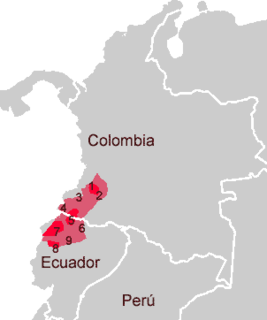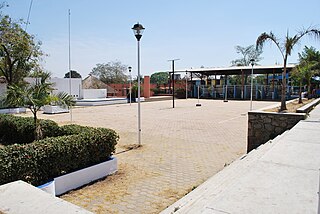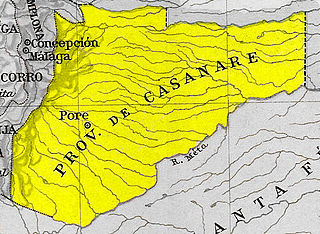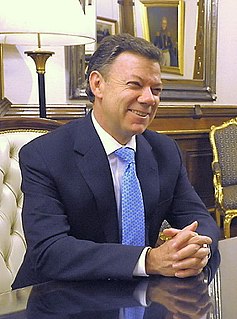
Cartago is a city in southwestern Colombia, about 187 miles west of Bogotá. It is in the extreme northern portion of the Valle del Cauca Department. It is located very close to the city of Pereira, about a 20-minute drive. It is the fourth largest city in Valle after Cali, Palmira, and Tuluá. In 2019, it had a population of approximately 135,000 inhabitants.

The National Liberation Army is a revolutionary left-wing armed group involved in the continuing Colombian conflict, which has existed in Colombia since 1964. The ELN advocate a composite communist ideology of Marxism-Leninism and liberation theology. In 2013, it was estimated that the ELN forces consisted of between 1,380 and 3,000 guerrillas. According to former ELN national directorate member Felipe Torres, one fifth of ELN supporters have taken up arms. The ELN has been classified as a terrorist organization by the governments of Colombia, United States, Canada the European Union and Venezuela's National Assembly.

Quibdó is the capital city of Chocó Department, in Western Colombia, and is located on the Atrato River. The municipality of Quibdó has an area of 3,337.5 km² and a population of 129,237, predominantly Afro Colombian and Zambo Colombians.

Barbacoan is a language family spoken in Colombia and Ecuador.

Cuajinicuilapa is a town in Cuajinicuilapa Municipality in the Costa Chica region of the Mexican state of Guerrero. A low-lying area, it borders the Pacific Ocean and the state of Oaxaca. The municipality has the state's largest population of Afro-Mexicans with most of the population of this ethnicity. The town and municipality are highly socioeconomically marginalized and it is the poorest municipality of the state, with the economy dependent on livestock and fishing.

Refugees of Iraq are Iraqi nationals who have fled Iraq due to war or persecution. Throughout the past 30 years, there have been a growing number of refugees fleeing Iraq and settling throughout the world, peaking recently with the latest Iraq War. Precipitated by a series of conflicts including the Kurdish rebellions during the Iran–Iraq War, Iraq's Invasion of Kuwait (1990) and the Gulf War (1991), the subsequent sanctions against Iraq, and culminating in the violence during and after the American-led invasion and occupation of Iraq, millions have been forced by insecurity to flee their homes in Iraq. Like the majority of refugees worldwide, Iraqi refugees have established themselves in urban areas in other countries rather than in refugee camps. In April 2007, there was an estimate of over four million Iraqi refugees around the world, including 1.9 million in Iraq, 2 million in neighboring Middle East countries, and around 200,000 in countries outside the Middle East. The United Nations High Commissioner for Refugees (UNHCR) has led the humanitarian efforts for Iraqi refugees. The Iraqi displacement of several million was the largest in the Middle East at the time, and was even larger than the number of Palestinians who were displaced in 1948 during the creation of the state of Israel.

Nevado del Huila at 5,364 metres (17,598 ft), is the highest volcano in Colombia, located at the tripoint of the departments of Huila, Tolima and Cauca. It is visible from the city of Cali. The andesitic volcano is located on top of the Ibagué Batholith.

The Guahibo people are an indigenous people native to the Llanos or savanna plains in eastern Colombia and in southern Venezuela near the Colombian border. Their population was estimated at 23,772 people in 1998.

Nóvita is a municipality and town in the Chocó Department, Colombia.

Afro-Colombians, African-Colombians, or Afrocolombianos (Spanish), are Colombians of aggregate or fractional Sub-Saharan African descent.

Puracé is a town and municipality in the Cauca Department, Colombia.
Saliba is an indigenous language of Eastern Colombia and Venezuela. Saliba was used by Jesuit missionaries in the 17th century to communicate with indigenous peoples of the Meta, Orinoco, and Vichada valleys. An 1856 watercolor by Manuel María Paz is an early depiction of the Saliva people in Casanare Province.

The Patía River is a river in southwestern Colombia. It flows over 400 kilometres (250 mi) to drain into the Pacific Ocean north of Tumaco. The Patía River is the longest river on the Colombian Pacific Coast. The last 90 kilometres (56 mi) is navigable by boat.

Casanare Province was one of the provinces of Gran Colombia.
Race and ethnicity in Colombia descends mainly from three racial groups—Amerindians, Europeans, and Africans—that have mingled throughout the last 500 years of the country's history. Some demographers describe Colombia as one of the most ethnically diverse countries in the Western Hemisphere and in the World, with 85 different ethnic groups. Most Colombians identify themselves and others according to ancestry, physical appearance, and sociocultural status. Social relations reflect the importance attached to certain characteristics associated with a given racial group. Although these characteristics no longer accurately differentiate social categories, they still contribute to one's rank in the social hierarchy. Genetic research determined that the average Colombian has a mixture of European 44%, native Amerindian 39,0 %, And 17,0 % african. These proportions also vary widely among ethnicities.

The Venezuelan migration and refugee crisis, the largest recorded refugee crisis in the Americas, refers to the emigration of millions of Venezuelans from their native country during the presidencies of Hugo Chávez and Nicolás Maduro because of the Bolivarian Revolution. The revolution was an attempt by Chávez and later Maduro to establish a cultural and political hegemony, which culminated in the crisis in Bolivarian Venezuela. The resulting refugee crisis has been compared to those faced by Cuban exiles, Syrian refugees and those affected by the European migrant crisis. The Bolivarian government has denied any migratory crisis, stating that the United Nations and others are attempting to justify foreign intervention within Venezuela.

The Venezuela–Colombia migrant crisis refers to a diplomatic and humanitarian crisis that occurred in mid-2015 following the shooting of three Venezuelan soldiers on the Venezuela–Colombia border that left them injured and President of Venezuela Nicolás Maduro's response of deporting thousands of Colombians. Maduro's response of declaring a state of emergency, closing the border to Colombia indefinitely and deporting thousands of Colombians that lived near the border, struck fear in tens of thousands of other Colombians living in Venezuela resulting in their emigration from the country and a crisis involving separated families and Colombians seeking food and shelter. The actions of President Maduro were questioned by human rights groups, the United States, the United Nations and the European Union.

The 2016 Nobel Peace Prize was awarded to the President of Colombia Juan Manuel Santos "for his resolute efforts to bring the country’s more than 50-year-long civil war to an end, a war that has cost the lives of at least 220,000 Colombians and displaced close to six million people." The conflict is the longest running war, and last remaining guerrilla struggle, in the Americas. The Nobel Peace Prize is awarded annually to those who have "done the most or the best work for fraternity between nations, for the abolition or reduction of standing armies and for the holding and promotion of peace congresses". The announcement was made on 7 October at a press conference at the Nobel Peace Center, and the formal award ceremony took place on 10 December at the Oslo City Hall.
The Chorographic Commission was a scientific project initially commissioned in 1850 by the Republic of the New Granada that was initially led by the Italian engineer Agustín Codazzi The purpose of the commission was to make a complete description of the New Granada and its provinces, but there were also economic interests, such as the research and acknowledgement of natural resources, the construction of means of transportation, the promotion of international commerce as well as foreign investment and immigration. In this sense there was also a political interest in the construction of a national identity where the mestizo culture was highlighted and there was a hierarchized representation of racial democracy. The commission took place in two stages; the first between 1850 and 1859, led by Agustín Codazzi, and the second between 1860 and 1862 by Manuel Ponce de León.

Danish Siddiqui was an Indian photo-journalist based in Mumbai, who used to head the national Reuters Multimedia team. He received the Pulitzer Prize in 2018, as part of the Reuters team, for documenting the Rohingya Refugee Crisis.

















